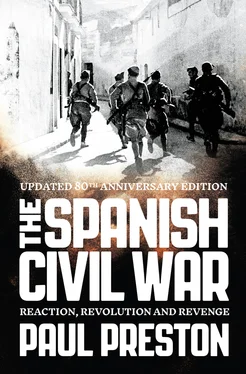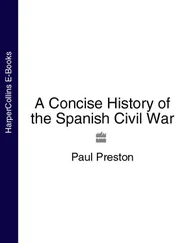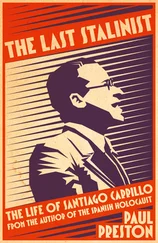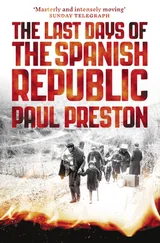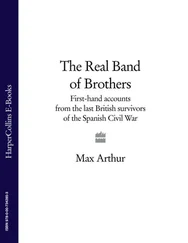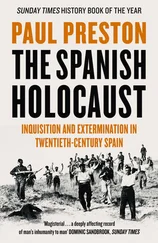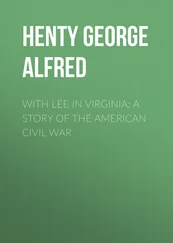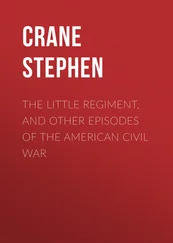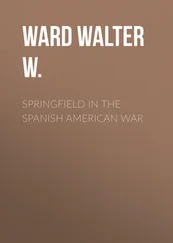The politics of reprisal were beginning to generate an atmosphere, if not of imminent civil war, certainly of great belligerence. The left saw fascism in every action of the right; the right smelt revolution in every left-wing move. Violent speeches were made in the Cortes and, at one point, guns flourished. In the streets shots were exchanged between Socialist and Falangist youths. Juan Antonio Ansaldo, a well-known monarchist playboy and aviator, had joined the Falange in the spring to organize terrorist squads. A plan to blow up the Madrid Casa del Pueblo was thwarted when the police discovered a large cache of arms and explosives. The actions of the Falangist hit squads provoked reprisals by the would-be revolutionaries of the Federatión de Juventudes Socialistas. The government’s attacks on regional autonomy and the increasingly threatening attitude of the CEDA were driving the Socialists to play with the idea of a revolutionary rising to forestall the destruction of the Republic.
The JAP held another rally, on 9 September, this time at Covadonga in Asturias, the starting point for the reconquest of Spain from the Moors. This was clearly a symbol of warlike aggression which foreshadowed the Francoist use after 1936 of the violent crusade imagery of the Reconquista . Gil Robles spoke in violent terms of the need to annihilate the ‘separatist rebellion’ of the Catalans and the Basque Nationalists. Revelling in the adulation of the assembled ranks of the JAP, the supreme Jefe worked himself up to a frenzy of patriotic rhetoric calling for nationalism to be exalted ‘with ecstasy, with paroxysms, with anything; I prefer a nation of lunatics to a nation of wretches’. Behind his apparently spontaneous passion was a cold-blooded determination to provoke the left. Gil Robles knew full well that the left considered him a Fascist. He was also aware that it intended to prevent the CEDA coming to power, although he was confident that the left was not in a position to succeed in a revolutionary attempt.
The preparations for revolution by the young Socialists had consisted largely of Sunday picnics in Madrid’s Casa del Campo during which military manoeuvres, without weapons, were amateurishly practised. Salazar Alonso had had no difficulty in tracking down the few revolvers and rifles that had been acquired by means of expensive encounters with unscrupulous arms dealers. Thanks to informers in the PSOE or to the arms dealers themselves, when the police subsequently raided the houses of militants and on Casas del Pueblo they seemed to know exactly where guns were concealed behind partitions or under floorboards. The most notorious arms purchase was carried out by Prieto, when arms – initially ordered by exiled enemies of the Portuguese dictatorship who could not pay for them – were shipped to Asturias on the steamer Turquesa . In a bizarre incident, the shipment fell largely into the hands of the police although Prieto escaped. Only in Asturias was the local working class even minimally armed, as a result of pilfering from local small-arms factories and dynamite available in the mines.
On 26 September the CEDA opened the crisis by announcing that it could no longer support a minority government. Lerroux’s new cabinet, announced late at night on 3 October, included three CEDA ministers. To the left, it seemed as if this was the first step towards the imposition of fascism in Spain. The reaction of the Republican forces was abrupt. Azaña and other leading Republicans denounced the move and even the conservative Miguel Maura broke off relations with the President. The Socialists were paralysed with doubt. They had hoped that threats of revolution would suffice to make Alcalá Zamora call new elections. Now, the UGT gave the government twenty-four hours’ notice of a pacific general strike. The Socialists hoped that the President would change his mind but they merely succeeded in giving the police time to arrest working-class leaders. In most parts of Spain, the strike was a failure largely because of the prompt action of the government in declaring martial law and bringing in the army to run essential services.
In Barcelona, events were more dramatic. In an attempt to outflank extreme Catalan nationalists, and seriously alarmed by developments in Madrid, Companys proclaimed an independent state of Catalonia ‘within the Federal Republic of Spain’. It was a protest against what was perceived as the Fascist betrayal of the Republic. The CNT stood aside since it regarded the Esquerra as a purely bourgeois affair. In fact, the rebellion of the Generalitat was doomed when Companys refused requests to arm the workers. Bloodshed was avoided by his moderation, which was matched by that of General Domingo Batet, the officer in command of the Catalan military region (or Fourth Organic Division, as it was called). General Batet employed common sense and restraint in restoring the authority of the central government. He ordered his men to be ‘deaf, dumb and blind’ before any provocations. In so preventing a potential blood bath, he incurred the wrath of General Francisco Franco, who was directing the repression from Madrid. Franco had sent warships to bombard the city and troops of the Foreign Legion. Batet ignored Franco’s recommendation to use the Foreign Legion to impose savage punishment on the Catalans and thus kept casualties to a minimum. In avoiding the exemplary violence that Franco regarded as essential, however, Batet was paving the way to his own execution by the Francoists during the Spanish Civil War.
The only place where the protests of the left in October 1934 were not easily brushed aside was in Asturias. There, spontaneous rank-and-file militancy impelled the local PSOE leaders to go along with a revolutionary movement organized jointly by the UGT, the CNT and, belatedly, the Communists, united in the Alianza Obrera (Workers’ Alliance). The local Socialist leaders of the mineworkers knew that the strike was doomed without support from the rest of Spain but they opted to stay with their men. The Minister of War, the Radical Diego Hidalgo, had given Franco informal control of operations. He made him his ‘adviser’ and used him as an unofficial Chief of the General Staff, by dint of marginalizing his own staff and dutifully signing the orders drawn up by Franco. The Minister’s decision was entirely comprehensible. Franco had detailed knowledge of Asturias, its geography, communications and military organization. He had been stationed there, had taken part in the suppression of the general strike of 1917 and had been a regular visitor since his marriage to an Asturian woman, Carmen Polo. What delighted the Spanish right was that Franco responded to the rebellious miners in Asturias as if he were dealing with the recalcitrant tribes of Morocco.
To this end, Franco brought in the hardened mercenaries of Spain’s colonial Army of Africa. Uninhibited by the humanitarian considerations which made other more liberal officers hesitate to use the full weight of the armed forces against civilians, Franco regarded the problem before him with the same icy ruthlessness that had underpinned his successes in the colonial wars. The miners organized a revolutionary commune with transport, communications, hospital facilities and food distribution, but had few weapons. Armed largely with dynamite, they were reduced to submission by both heavy artillery attacks and bombing raids. The Spanish Foreign Legion committed atrocities, many women and children were killed and, when the principal Asturian cities, Gijón and Oviedo, fell, the army carried out summary executions of leftists. Franco commented casually to a journalist, ‘The war in Morocco, with the Regulares and the Legion, had a certain romantic air, an air of reconquest. But this war is a frontier war and its fronts are socialism, communism and whatever attacks civilization in order to replace it with barbarism.’
Читать дальше
